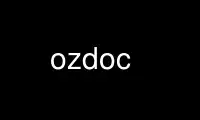
This is the command ozdoc that can be run in the OnWorks free hosting provider using one of our multiple free online workstations such as Ubuntu Online, Fedora Online, Windows online emulator or MAC OS online emulator
PROGRAM:
NAME
ozdoc - Produce documentation using the ozdoc DTD
SYNOPSIS
ozdoc options...
DESCRIPTION
The Oz Documentation DTD provides a means to markup technical
documentation so
that it is easy to convert it to alternative publication formats
such as LaTeX and HTML. ozdoc can be used to process SGML
sources written according to the Oz Documentation DTD.
OPTIONS
--in=file
The input SGML file.
--type=type
What output to generate (supported types: html-color, html-mono,
html-stylesheets, html-global-index, chunk)
--out=directory
The output directory.
--(no)autoindex
Automatically generate index entries.
--include=A1,...,An
Assume '<!ENTITY & Ai "INCLUDE">'.
--link=text,relURL
Include a link in the margin of each page.
--stylesheet=relURL
What style sheet to use for generated pages.
--(no)latextogif
Generate GIF files from LaTeX code.
--latexdb=file
Reuse GIFs generated from LaTeX code.
--(no)split
Split the document into several nodes.
--(no)abstract
Generate an abstract.html auxiliary file.
--keeppictures
Do no recreate GIF from PS if already there.
--xrefdb=file
Where to look up respectively store references.
--xrefdir=relURL
Where this document goes relative to the whole documentation
installation directory.
--xreftree=relURL
How to get to whole doc installation from the directory where
this document goes.
--indexdb=file
Where to look up respectively store index entries.
--make-hhc=file
Where to write a HTML Help contents file.
--ozdoc-home=directory
ozdoc installation directory.
--author-path=path
--bib-path=path
--bst-path=path
--sbin-path=path
Where to look for author databases, bib files, bst files, and
ozdoc scripts.
--catalog=file
Specify the catalog file to use for parsing.
Use ozdoc online using onworks.net services
